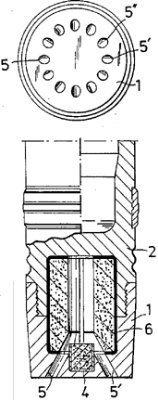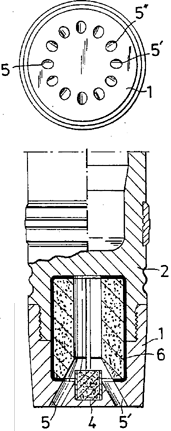
Base bleed
Encyclopedia

Artillery
Originally applied to any group of infantry primarily armed with projectile weapons, artillery has over time become limited in meaning to refer only to those engines of war that operate by projection of munitions far beyond the range of effect of personal weapons...
shells to increase their range, typically by about 30%.
Most of the drag
Drag (physics)
In fluid dynamics, drag refers to forces which act on a solid object in the direction of the relative fluid flow velocity...
on an artillery shell comes from the nose of the shell, as it pushes the air out of its way at supersonic speeds. Shaping the shell properly can reduce this greatly. However, another powerful source of drag is the vacuum left behind the shell due to its blunt base. This drag is difficult to remove, because the shell needs to be "nose heavy" in order to have proper ballistics
Ballistics
Ballistics is the science of mechanics that deals with the flight, behavior, and effects of projectiles, especially bullets, gravity bombs, rockets, or the like; the science or art of designing and accelerating projectiles so as to achieve a desired performance.A ballistic body is a body which is...
, and it cannot easily be shaped into a more aerodynamic
Aerodynamics
Aerodynamics is a branch of dynamics concerned with studying the motion of air, particularly when it interacts with a moving object. Aerodynamics is a subfield of fluid dynamics and gas dynamics, with much theory shared between them. Aerodynamics is often used synonymously with gas dynamics, with...
form.
Base bleed is one way to reduce this drag without extending the base of the shell. Instead, a small ring of metal extends just past the base, and the area in the rear of the shell is filled with a small gas generator. The gas generator provides little net thrust
Thrust
Thrust is a reaction force described quantitatively by Newton's second and third laws. When a system expels or accelerates mass in one direction the accelerated mass will cause a force of equal magnitude but opposite direction on that system....
, but simply fills the area behind the shell with pressure, dramatically reducing the drag due to the vacuum. The only downsides are a small loss of accuracy due to the somewhat more turbulent
Turbulence
In fluid dynamics, turbulence or turbulent flow is a flow regime characterized by chaotic and stochastic property changes. This includes low momentum diffusion, high momentum convection, and rapid variation of pressure and velocity in space and time...
airflow, and a small loss in explosive payload due to some of the shell being taken up by the engine.
Since base bleed extends the range by a percentage, it is only really useful on longer range artillery. Until recently the loss in explosive was not considered worthwhile for the small gains in range. However, the introduction of much longer range systems based on the GC-45 howitzer
GC-45 howitzer
The GC-45 is a 155 mm howitzer designed by Gerald Bull's Space Research Corporation in the 1970s. Versions were produced by a number of companies during the 1980s, notably in Austria and South Africa...
has changed the equation somewhat, as 30% extra range on these systems represents 5 to 10 km. Base bleed shells are starting to become more common in units equipped with modern artillery of this type.
History
The principles were developed in a joint effort between the Swedish 'Försvarets forskningsanstalt' (Defence Research Agency), FOA and the artillery bureau at Kungliga MaterielFörvaltningen, KFM (later known as Försvarets MaterielVerk, FMV) in the latter part of the 1960s in order to increase the range of the coastal artillery.By 1966, it had been concluded that a small, slow-burning charge at the base of the projectile would positively reduce the vacuum behind it and hence increase the range due to the lower drag.
The first full scale tests took place in 1969 with modified 10.5 cm steel shells with excellent results, and the Swedish patent was made in 1971.
The concept was quickly implemented into the 7,5 cm sjömålsgranat m/66 (anti-shipping shell m/66) used in the coastal fortification system 7,5/m57, and then rapidly into all anti-ship shells in the Swedish military.
Since the gas-generator for the 12 cm sjömålsgranat m/70 was to be manufactured by a company in the USA, the classification "secret" was removed from the patent.
Shortly thereafter, the international rights were sold out ending up with Space Research Corporation (SRC), owned by the artillery genius Gerald Bull
Gerald Bull
Gerald Vincent Bull was a Canadian engineer who developed long-range artillery. He moved from project to project in his quest to launch economically a satellite using a huge artillery piece, to which end he designed the Project Babylon "supergun" for the Iraqi government...
.
See also
- Rocket Assisted ProjectileRocket Assisted ProjectileA Rocket Assisted Projectile is an artillery or cannon round incorporating a rocket motor for independent propulsion. This grants the projectile both greater speed and range than an ordinary shell, which is propelled only by the ballistic force of the gun's exploding charge...
(RAP) - velocity enhanced long range artillery projectile (VLAP)

